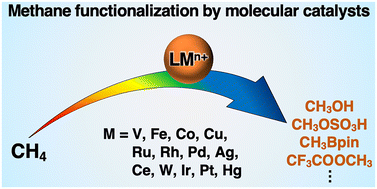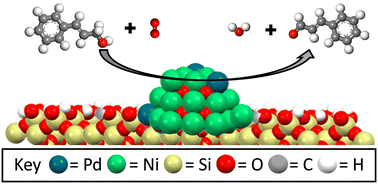Themed collection Oxidation for a Sustainable Future and Clean Environment

Functionalization of methane using molecular metal complexes as catalysts
Efficient and selective functionalization of methane is one of the most important tasks in chemistry in light of its utilization as a naturally abundant feedstock toward the development of a sustainable society.

Catal. Sci. Technol., 2023,13, 4270-4284
https://doi.org/10.1039/D3CY00647F
Construction of a g-C3N4-driven photocatalytic system for boosted biomass-derived alcohol oxidation: a promising route towards sustainable biomass valorization
We present feasible regulation strategies of a g-C3N4-based photocatalytic system for selective oxidation of biomass-derived alcohols for better biomass valorization.

Catal. Sci. Technol., 2023,13, 940-957
https://doi.org/10.1039/D2CY01860H
Isolated PdO sites on SiO2-supported NiO nanoparticles as active sites for allylic alcohol selective oxidation
Silica-supported NiO nanoparticles as hosts for isolated PdO catalytic sites. Isolate PdO is confirmed as the species responsible for the chemoselective oxidation of cinnamyl alcohol to cinnamaldehyde by operando X-ray absorption spectroscopy.

Catal. Sci. Technol., 2023,13, 3483-3488
https://doi.org/10.1039/D3CY00198A
Ruthenium ion catalysed C–C bond activation in lignin model compounds – towards lignin depolymerisation
Ruthenium ion catalyzed oxidative depolymerisation of lignin model hexamer.

Catal. Sci. Technol., 2023,13, 5912-5923
https://doi.org/10.1039/D3CY00076A
The selective oxidation of methane to methanol using in situ generated H2O2 over palladium-based bimetallic catalysts
The selective oxidation of methane to methanol, using in situ generated H2O2 has been investigated using a series of TS-1 supported palladium-based catalysts, with the introduction of Au or Ni considerably improving catalytic performance.

Catal. Sci. Technol., 2023,13, 5848-5858
https://doi.org/10.1039/D3CY00116D
Upgrading the reflux method as novel route for competitive catalysts in alkane selective oxidation
Optimized reflux synthesis of MoVTeNbo catalysts.

Catal. Sci. Technol., 2023,13, 4802-4812
https://doi.org/10.1039/D3CY00372H
Peroxomolybdate@MOFs as effective catalysts for oxidative desulfurization of fuels: correlation between MOF structure and catalytic activity
The highly active peroxomolybdate, TBA3{PO4[MoO(O2)2]4}·3H2O was incorporated for the first time in various porous MOF support structures (MIL-101, MOF-808, and ZIF-8) to form heterogeneous catalysts with different structural properties.

Catal. Sci. Technol., 2023,13, 4785-4801
https://doi.org/10.1039/D3CY00467H
Tuning catalysis by surface-deposition of elements on oxidation catalysts via atomic layer deposition
This study on surface-modifications of bulk oxidation catalysts with sub-monolayers of POx, BOx and MnOxvia atomic layer deposition demonstrates this method to be a powerful tool for tuning the performance in selective oxidations of light alkanes.

Catal. Sci. Technol., 2023,13, 4117-4130
https://doi.org/10.1039/D2CY02184F
Sustainable synthesis of azobenzenes, quinolines and quinoxalines via oxidative dehydrogenative couplings catalysed by reusable transition metal oxide–Bi(III) cooperative catalysts
Heterogeneous catalytic oxidative dehydrogenative processes for N-heterocycles are presented, which enable waste-minimized (additive-, oxidant-, base-free), efficient cyclisations/couplings via transition metal oxide–Bi(III) cooperative catalysis.

Catal. Sci. Technol., 2023,13, 3069-3083
https://doi.org/10.1039/D3CY00327B
Catalytic oxidation of NO to NO2 for industrial nitric acid production using Ag-promoted MnO2/ZrO2 catalysts
Low-temperature nitric oxide oxidation using silver promoted manganese catalyst can reduce energy footprint of industrial nitric acid production.

Catal. Sci. Technol., 2023,13, 2783-2793
https://doi.org/10.1039/D2CY02178A
Oxidation of ethylene by Cu/TiO2: reducibility of Cu2+ in TiO2 as a possible descriptor of catalytic efficiency
Catalytic oxidation using non-noble metal-based catalysts is a promising approach to mitigate pollution due to VOCs in the air.

Catal. Sci. Technol., 2023,13, 2330-2339
https://doi.org/10.1039/D2CY02170F
A sustainable iron-catalyzed aerobic oxidative C–C and C–O bond cleavage of a lignin model to phenol and methyl benzoate
A sustainable and heterogeneous iron-mediated oxidative cleavage of lignin to phenol and methyl benzoate is achieved in the presence of molecular oxygen.

Catal. Sci. Technol., 2023,13, 1748-1754
https://doi.org/10.1039/D2CY01763F
Tetra-n-butylammonium decatungstate supported on Fe3O4 nanoparticles: a novel nanocatalyst for green synthesis of nitroso compounds
The Fe3O4/TBADT composite catalyst (M-DT) can efficiently oxidize aromatic amine compounds selectively into nitroso compounds in the presence of H2O2. The high efficiency is due to the strong interaction between Fe3O4 and TBADT.

Catal. Sci. Technol., 2023,13, 1000-1008
https://doi.org/10.1039/D2CY01862D
Gas-phase oxidative dehydrogenation of long chain alkenols for the production of key fragrance ingredients: from Rosalva isomers to Costenal analogues
Continuous-flow, gas-phase selective oxidative dehydrogenation (ODH) of unsaturated long chain alcohols (i.e. decen-1-ol isomers) to the corresponding aldehydes over an innovative, highly dispersed Cu-based catalyst supported over ferrite.

Catal. Sci. Technol., 2023,13, 1059-1073
https://doi.org/10.1039/D2CY01836E
About this collection
This Catalysis Science & Technology special collection of articles, Guest Edited by Professor David Willock (Cardiff University), showcases research related to the 9th World Congress on Oxidation Catalysis conference theme: “Oxidation for a sustainable future and clean environment” held in Cardiff, UK on 4th - 8th September 2022. Oxidation is a key technology that is central to the world’s move toward a sustainable chemicals and energy economy and the work featured in this collection highlights research spanning a broad range of oxidation science, technology, and applications.